GP Shortages in Ireland: Mapping Medical Deserts, Travel Times & Age Gaps
Author: Charlotte Cuffe, Chief Data Scientist at Gamma Labs
A recent report from The Irish College of General Practitioners (Press Release GP workforce – Irish College of General Practitioners Website) found that GP shortages in Ireland exceed the recommended level for its population. In 2023 there were 4,456 practicing GPs, while the population in 2022 was 5,123,536. That works out to 1,150 people per GP, or 8.7 GPs per 10,000 people.
When Gamma’s spatial analysts saw this, they considered how this ratio was distributed around the country. We also considered whether there is any relationship with age cohort demographics – do older people tend to live in areas better-supplied or worse-supplied with GP practices?
To find the answers, we applied spatial analysis and dug into several data sources at our disposal. These included GP practice locations (mapped to address level), average practice size (number of doctors per practice) per county, and 2022 small area Census of Population and age profile data. We also ran the data through our point-to-point drive time calculation system using our road network and drivetime model.
This analysis considers two aspects of the problem of access to GP services. The first is excessive distance or travel time to services and the second is undersupply of GPs relative to the population size.
Older Adults
Older adults usually require more regular GP care, especially for chronic conditions and early interventions. As of Census night 2022, 10.5% of the population were aged 70 or older.
Throughout this analysis, we take highlight how this cohort fares for access to GP services, both in terms of travel time and in terms of supply vs demand.
Drivetime Accessibility
On average, 88% of people in Ireland live within 10 minutes drivetime of a GP practice, and 97% are within 15 minutes. However, approximately 149,000 people live more than 15 minutes’ off-peak drive from their closest GP.
Of these groups, there are 3,596 people in areas more than 30 minutes’ drivetime from a GP practice, and a few remote parts of Donegal, Cork and Kerry are more than 45 minutes away from the closest GP practice.
Of those who live more than 15 minutes away from their closest GP, 13% are aged 70 or older, compared to just 10.0% of those who live within a 5-minute drive time.
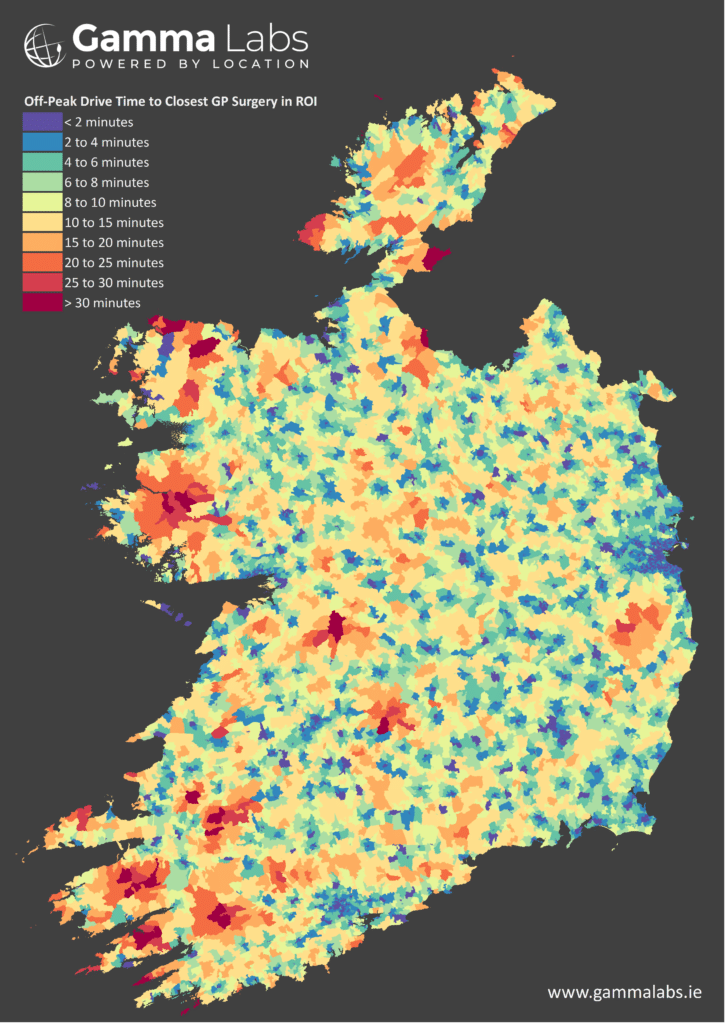
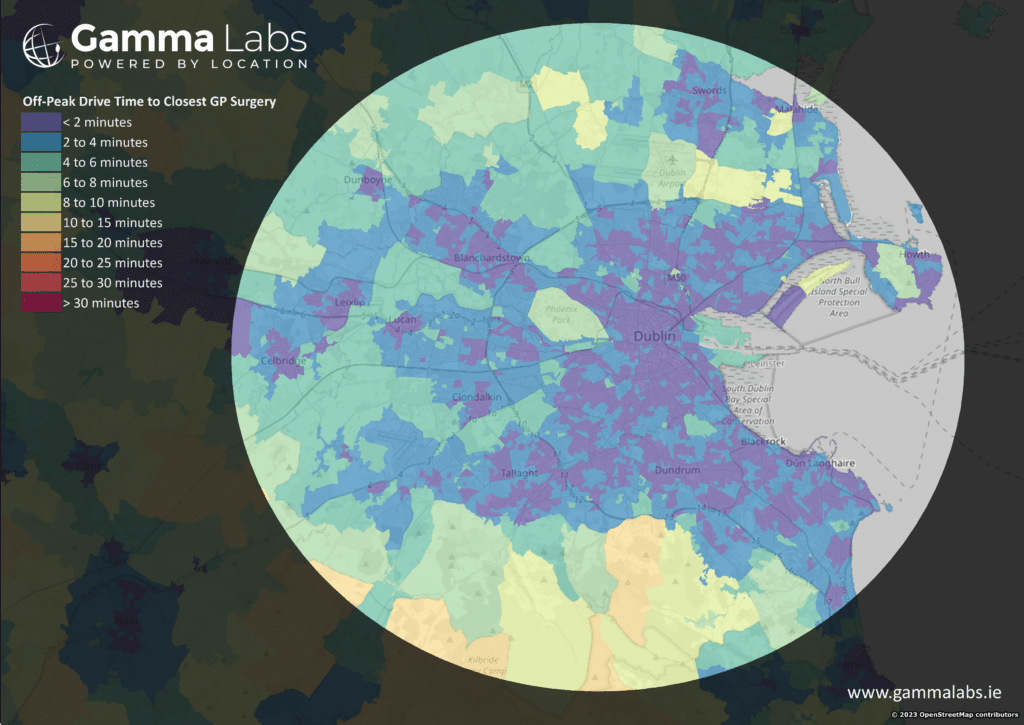
Supply and Demand
On a national level, the average remains 1 GP per1,150 residents. However, there are both well-served areas where the number of GPs per capita is higher than this and under-served areas where the ratio is lower.
To understand the geographic variation in supply and demand, our team looked for clusters of GP surgeries that are close together. There are 680 places with either a single GP surgery or a cluster of GP surgeries. We then considered the catchment around each surgery or group of surgeries on the basis of off-peak drive time. This allowed us to estimate the ratio of population to GP for each of these 680 places, identifying areas with more and fewer than the average number of doctors per capita.
Of the ten most under-served areas, three are in County Kildare (Prosperous, Kildare Town and Monasterevin), and four are in West Dublin (Griffeen, Castaheany, Citywest and Jobstown).
Other areas where the supply is GPs is notably low compared to the population are Ballymahon in County Longford, Duleek in County Louth, and Castletroy in Limerick.
GP Shortages for Older Adults
Next, we examined whether these shortages also affect areas with higher concentrations of older adults.
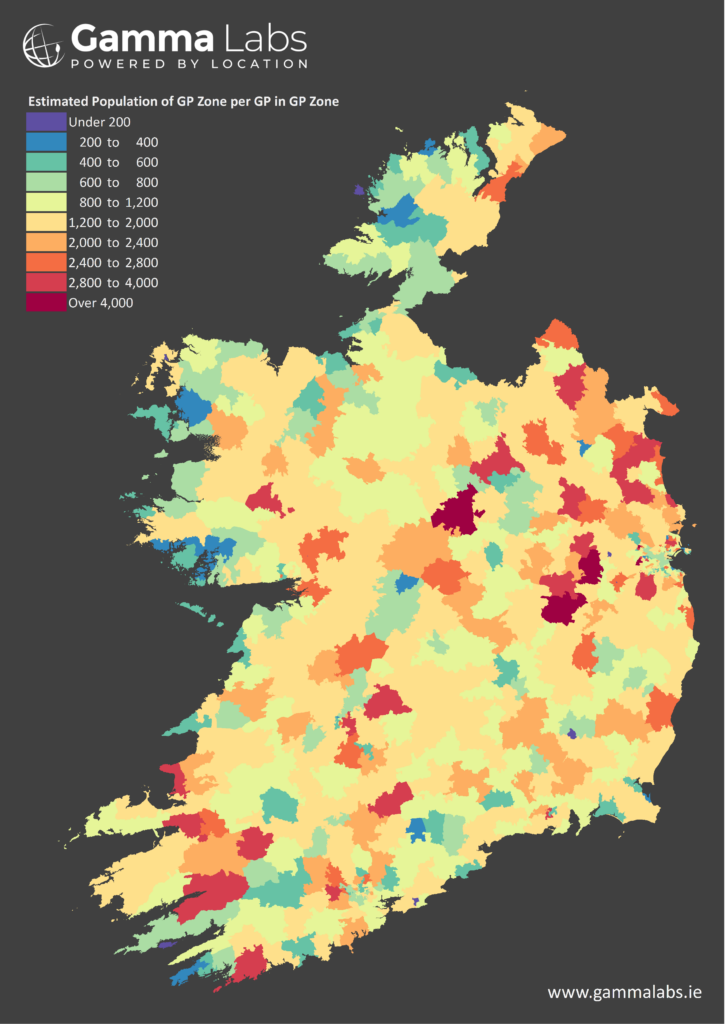
On average, there were 120 people aged 70 and over per GP in the country. However, there are areas where the ratio of older adults to GPs is significantly higher than that. Among areas with a significant undersupply of GPs relative to population, some stand out as additionally having a large proportion of the population aged 70 and older.
Some of the areas with an undersupply of GPs overall and a large proportion of older adults are:
- Skibbereen in County Cork (3.2 GPs per 10,000 people; 15% aged 70 and over)
- Ferbane in County Offaly (3.9 GPs per 10,000 people; 14% aged 70 and over)
- Kenmare in County Kerry (2.6 GPs per 10,000 people; 14% aged 70 and over)
- Ardfert in County Kerry (3.4 GPs per 10,000 people; 14% aged 70 and over)
- Kilkelly in County Mayo (4.7 GPs per 10,000 people; 17% aged 70 and over)
- Several Dublin suburbs:
- Bayside (3.6GPs per 10,000 people; 20% aged 70 and over)
- Glenageary (3.7 GPs per 10,000 people; 19% aged 70 and over)
- Dalkey (6.2 GPs per 10,000 people; 24% aged 70 and over)
- Artane (4 GPs per 10,000 people; 21% aged 70 and over)
- Walkinstown (5.4 GPs per 10,000 people; 20% aged 70 and over)
- Blackrock (5.1 GPs per 10,000 people; 18% aged 70 and over)
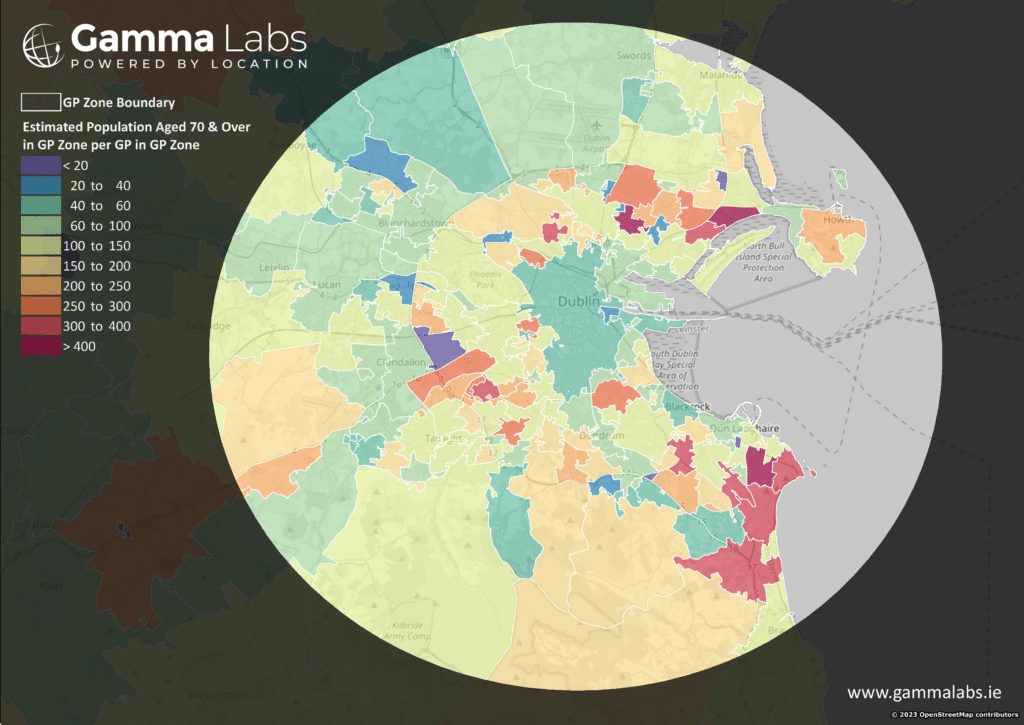
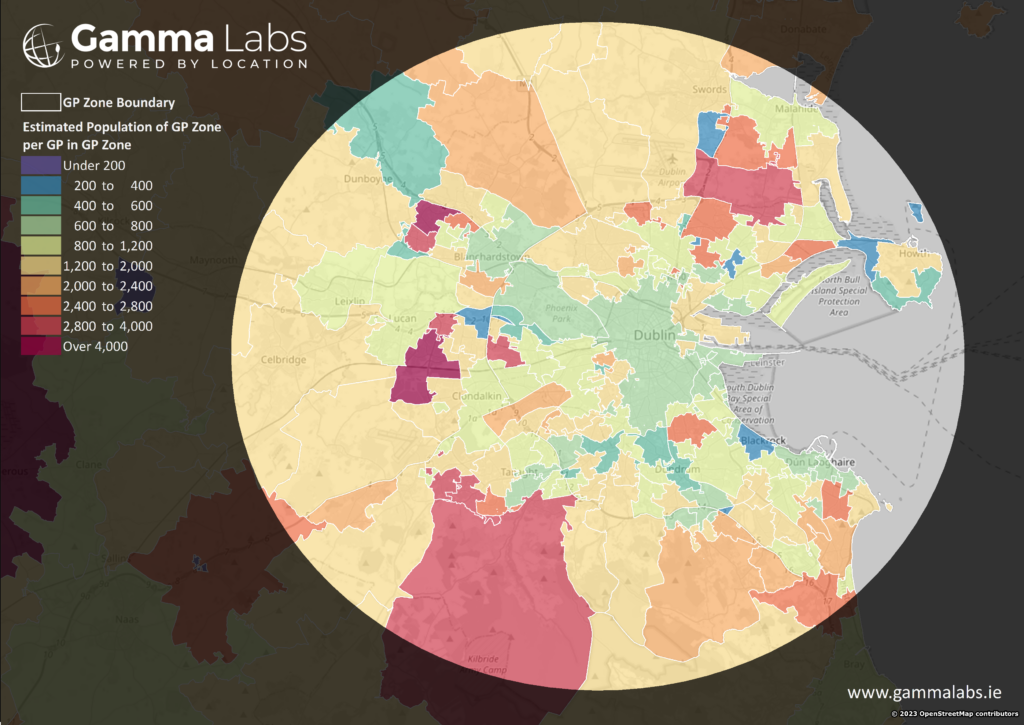
Relevant Reports & Publications
According to the ESRI, demand for GP appointments will increase by 23% to 30% by 2040. To meet this, Ireland needs nearly 1,200 additional GPs.
The ICGP has warned that 30% of Irish GPs plan to retire by 2028, and up to 15% are considering emigration.
The government has promised to expand GP training places by 50% over the next five years.
Final Thoughts
In summary, Ireland currently has 8.7 GPs per 10,000 people, or roughly 1 per 1,150 residents. But that figure masks the very real problem of medical deserts. In some areas, the patient load is far higher. And in others, access can mean a 20-minute drive or longer—if you’re lucky enough to be mobile.
If we want to understand availability and shortages of medical care, spatial analysis and pinpoint mapping of services and populations is an invaluable tool to support better, data-driven decisions.
Notes & Metadata
*Notes on Data sources, Methodology, Assumptions and Calculations
- GP practice locations are sourced from Gamma Location Labs and mapped to the address level. Only ROI GP practices are included in this analysis.
- Number of doctors: the number of doctors per GP practice is assumed to be the average practice size per county. The average practice size is calculated as the number of practicing GPs 2023 per county divided by the number of GP practices 2024 per county.
- All distances are off-peak drive time unless otherwise specified.
- Census small areas are blocks of approximately 100 households. They are the most detailed statistical geography used by the Central Statistics Office for reporting on population and demographics.
- GP zones are created as follows:
- Small areas are assigned to their closest GP based on off-peak drive time to create GP catchments.
- Where there is more than one GP practice in a settlement of 500 to 50,000 people, the catchments of all the GPs in the settlement are combined to form a GP Zone.
- In rural areas and in cities of more than 50,000 people, clusters of GP practices within 600 metres’ crow-flies distance of each other are identified. The catchments of GPs in the same GP cluster are combined to form a single GP Zone.
- Population figures come from the 2022 Census of Population carried out by the Central Statistics Office.
- Age Profile figures come from the 2022 Census of Population carried out by the Central Statistics Office.



